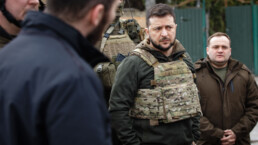There are limits to what Kyiv can do, even with an indefinite flow of Western assistance.
by Mark Episkopos, Responsible Statecraft
There is little secret that proponents of total victory in Ukraine have trained their focus on ensuring that a $60 billion Ukraine military aid package, introduced by the Biden administration late last year, is passed by Congress. Its backers claim this aid is of vital, even existential importance, but what effects could this package actually have on the battlefronts in Ukraine and what is really at stake in the debate over Ukraine aid more broadly?
The funding, part of a larger $95 billion supplemental package for Ukraine, Israel and Taiwan, allocates $20 billion to replenish Department of Defense stockpiles after previous rounds of Ukraine aid, around $14 billion for Ukraine to purchase weapons from U.S. entities, $15 billion in support including intelligence services and military training, and $8 billion in direct budget support for the Ukrainian government. This sum, though prodigious in an absolute sense, pales in comparison to the $113 billion in Ukraine aid approved by Congress in 2022 during a time in the war when the balance of forces was much more favorable to the Armed Forces of Ukraine (AFU) than it is now.

The AFU faces a cascade of critical challenges; prime among them are its growing shortage of troops and its dire munitions deficit in what, according to Ukrainian officials, has become an “artillery war.” The aid package strives to alleviate Ukraine’s mounting shell hunger, but money does not directly translate into readily-available munitions. It is not clear how many shells, and how quickly, the U.S. can send Ukraine even if the supplemental was approved today. Russia, according to estimates by RUSI from earlier this year, fires 10,000 artillery rounds per day. Consider, for a sense of scale, that European annual production by February 2023 totaled just 300,000 rounds — or roughly what Russia has spent every month in Ukraine. Russia — which is believed to have made around 2 million artillery shells in 2023 — outproduced its Western counterparts at a rate of seven to one, according to an Estonian intelligence assessment from last year.
Recent Posts
“Arrest Now, Ask Questions Later”: Why Did L.A. ICE Agents Arrest and Jail U.S. Citizen Andrea Velez?
July 3, 2025
Take Action Now “They didn’t have vests that said ICE or anything. Their cars didn’t have license plates. … Just because of the color of our…
Trump’s Big, Beautiful Bill Is Naked Class War
July 3, 2025
Take Action Now Trump’s “Big, Beautiful Bill” trades tax cuts on millionaires for the dissolution of society.By Hamilton Nolan, In These Times…
Mayor Mamdani’s First Day, A Zero Hour Conversation With Richard Wolff
July 2, 2025
Take Action Now If elected, what would Mayor Mamdani do on his first day in City Hall? How would a democratic socialist govern as a big-city mayor?……
The U.S. Is Funding A Bloodbath At Gaza Aid Centers
July 2, 2025
Take Action Now The admin just gave $30M to GHF, the organization at the center of charges that Israel is weaponizing assistance and shooting at…




